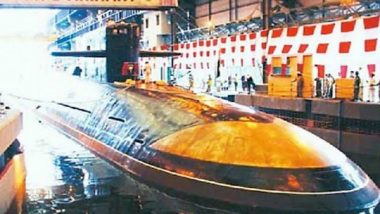New Delhi, October 4: Against the backdrop of Australian decision to scrap a USD 90 billion deal with France to build conventional diesel-electric submarines and opt for building nuclear boats only, a senior government official on Monday said the Indian Navy will operate a mix of both nuclear and conventional submarines to deal with the threats around the country.
"For Australia, the threat is more in the open oceans and the areas around that area. The decision to scrap a conventional submarine deal makes sense for them. While for us, the need is to tackle threats both near our coastal areas as well as open seas. That is why the Indian Navy would build a fleet which would include both nuclear as well as conventional submarines," a senior government official told ANI. Also Read | Lakhimpur Kheri Violence: Punjab CM Charanjit Channi Denied Permission To Visit in View of Law and Order Situation.
The official was commenting on the ongoing debate on whether India and other navies should follow suit and go for building only nuclear submarines as they are more capable and stealthier than conventional submarines. Also Read | Realme GT Neo2 Teased in India, Launch Expected Soon.
Notably, after scrapping the deal, Australia has joined hands with the Americans who would now help Canberra build nuclear attack submarines to tackle the main threat from the Chinese Navy.
For a country like India, having a mix of both types of submarines makes more sense economically as well as the cost of operating and building nuclear attack submarines is more than double of building conventional diesel-electric submarines, according to the official.
As far as the economics of the project goes, the entire project to build six nuclear submarines under the Kalvari class (Scorpene) boats for India would come around Rs 25,000 crore on completion whereas the proposal to build the first three nuclear attack submarines to be built by the Defence Research and Development Organisation (DRDO) at its Submarine Building Centre would cost more than Rs 50,000 crore, said the senior official.
Even though the cost difference between the nuclear and conventional submarines is substantial, the nuclear boats provide a huge capability to the navies as the boats can stay underwater for months without the need to come out on the surface at regular intervals as is required by conventional boats to charge their batteries.
Indian Navy has plans of operating 24 new submarines of which six are of the Kalvari class, six would be built under Project 75 India whose tender has been issued and a proposal for building six nuclear submarines is pending with the Cabinet Committee on Security. The decision on the last batch of six submarines under the plan would be taken at a later stage, the sources said.
At present, India has a fleet of Russian-origin Kilo Class, German-origin HDWs and an indigenous ballistic nuclear submarine in the form of 'INS Arihant'. Five nuclear submarines were re-planned to be built under the Arihant Class project which is separate from the 24 submarine programme.
Across the world, major navies like the American, French, British and now Australian have switched over to nuclear submarine fleet only but the Chinese and Russian Navy operate a mix of both nuclear and conventional submarines, the official said.
India has been leasing nuclear attack submarines from Russia for the last three decades and is in the process of leasing another one soon from there.
(The above story is verified and authored by ANI staff, ANI is South Asia's leading multimedia news agency with over 100 bureaus in India, South Asia and across the globe. ANI brings the latest news on Politics and Current Affairs in India & around the World, Sports, Health, Fitness, Entertainment, & News. The views appearing in the above post do not reflect the opinions of LatestLY)













 Quickly
Quickly


